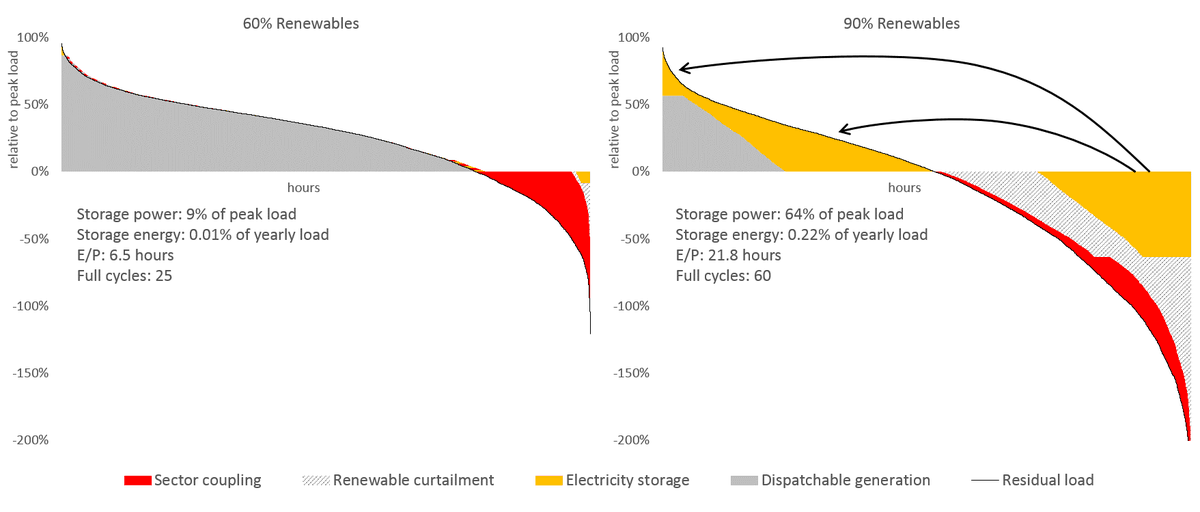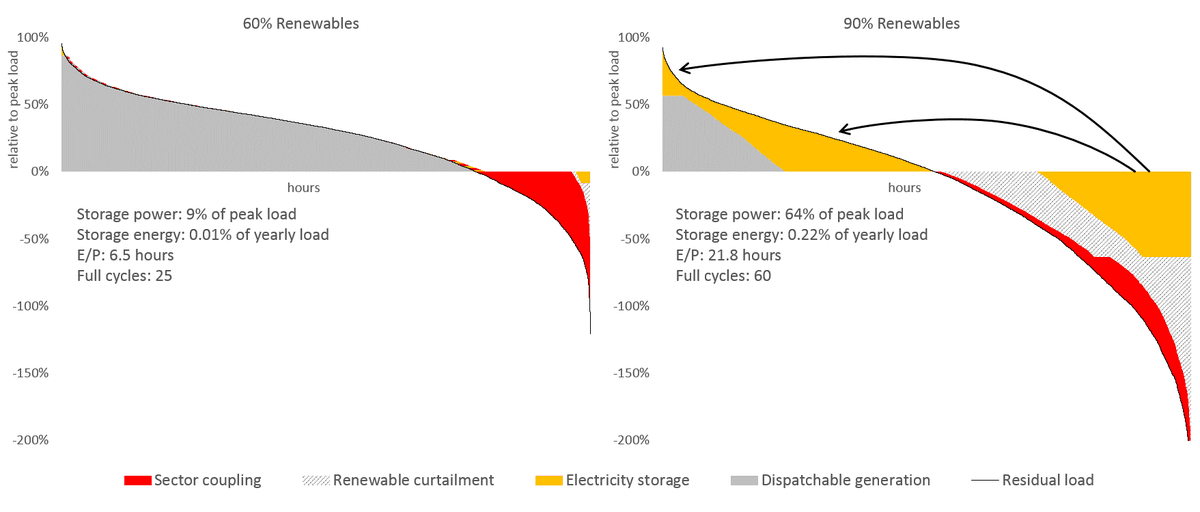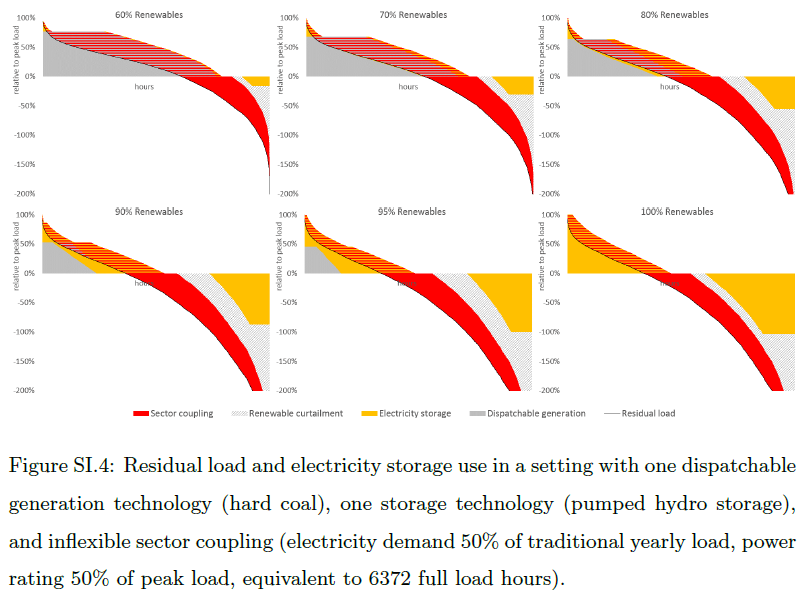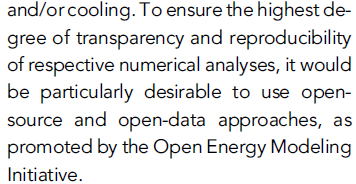1/ Hi #energytwitter, I& #39;m excited to share my thoughts on the changing role of #electricity #storage in the #renewable #energy transition in my new @Joule_CP Commentary! @CellPressNews  https://abs.twimg.com/emoji/v2/... draggable="false" alt="🔋" title="Batterie" aria-label="Emoji: Batterie">
https://abs.twimg.com/emoji/v2/... draggable="false" alt="🔋" title="Batterie" aria-label="Emoji: Batterie">
https://doi.org/10.1016/j.joule.2020.07.022
A">https://doi.org/10.1016/j... little thread https://abs.twimg.com/emoji/v2/... draggable="false" alt="⬇️" title="Pfeil nach unten" aria-label="Emoji: Pfeil nach unten">
https://abs.twimg.com/emoji/v2/... draggable="false" alt="⬇️" title="Pfeil nach unten" aria-label="Emoji: Pfeil nach unten">
https://doi.org/10.1016/j.joule.2020.07.022
A">https://doi.org/10.1016/j... little thread
2/ I discuss three strands of the literature, and illustrate how the main driver for (bulk) electricity storage deployment shifts from taking up renewable surplus generation to supplying peak residual load when the renewable share increases (and what changes with sector coupling)
3/ I do so with residual load duration curves (RLDC) from a stylized #opensource model. The RL in one hour is the electric load during this hour, minus the potential generation of variable renewables. A RLDC sorts all hourly RL values of a full year in descending order https://abs.twimg.com/emoji/v2/... draggable="false" alt="🤓" title="Nerd-Gesicht" aria-label="Emoji: Nerd-Gesicht">
https://abs.twimg.com/emoji/v2/... draggable="false" alt="🤓" title="Nerd-Gesicht" aria-label="Emoji: Nerd-Gesicht">
4/ Let& #39;s first look at a stylized power sector (without sector coupling): with 60% renewables, storage takes up renewable surplus generation on the right-hand side of the RLDC and shifts it to hours on the left-hand side where residual load is positive, but low (left panel).
5/ Note that electricity storage does not fully take up the renewable surplus in a least-cost solution. A fraction is also curtailed, as investments in storage energy and power incur costs. We also explored this in previous work with A. Zerrahn @CKemfert: https://doi.org/10.1016/j.euroecorev.2018.07.004">https://doi.org/10.1016/j...
6/ With 60% renewables, electricity storage only makes a minor contribution to peak residual load coverage on the left-hand side of the RLDC, as this would require much larger storage energy capacity, which is more costly than supplying peak load with dispatchable generation.
7/ If the renewable share increases to 90%, much more electricity storage is used, with increasing E/P ratio. This is driven by larger renewable surpluses, but also by an increasing contribution of storage to peak residual load on the very left-hand side of the RLDC (right panel)
8/ Let& #39;s now consider a stylized setting with flexible sector coupling. Here I assume some generic, additional & flexible loads such as #powertoheat or #powertogas (without reconversion to electricity), with related low-cost heat or gas storage options.
9/ In a setting with 60% renewables, moderate levels of flexible sector coupling could almost completely substitute both electricity storage and renewable curtailment, as this allows making use of most of the renewable surplus generation (left panel).
10/ This mitigating effect on electricity storage vanishes if the renewable share increases to 90%. This is because sector coupling is small cp. to the renewable surplus in this setting, and it also does not contribute to peak residual load on the left-hand side (right panel).
11/ In a  https://abs.twimg.com/emoji/v2/... draggable="false" alt="💯" title="Hundert Punkte Symbol" aria-label="Emoji: Hundert Punkte Symbol">% renewable scenario, even massive sector coupling hardly changes optimal electricity storage deployment, as storage is no longer driven by making use of renewable surpluses; instead, it is needed for supplying positive residual load on the left-hand side of the RLDC.
https://abs.twimg.com/emoji/v2/... draggable="false" alt="💯" title="Hundert Punkte Symbol" aria-label="Emoji: Hundert Punkte Symbol">% renewable scenario, even massive sector coupling hardly changes optimal electricity storage deployment, as storage is no longer driven by making use of renewable surpluses; instead, it is needed for supplying positive residual load on the left-hand side of the RLDC.
12/ Note that optimal storage power and, even more so, storage energy capacity substantially increase when the share of variable renewables grows from 90% to 100%. In turn, yearly storage cycles decrease.
13/ I provide many additional figures in the SI, e.g. for different assumptions on storage and sector coupling. If sector coupling is less flexible (e.g. electrolyser with high full-load hours), this can *increase* storage needs as taking up renewable surpluses is less feasible.
14/ I conclude that concerns about a possible shortage of electricity storage are currently no reason to slow down renewable deployment. In highly renewable systems, longer-term storage becomes key, so R&D should focus on this - which is likely to involve green #hydrogen techs.
15/ Yet pure R&D may not suffice. Experiences with solar PV showed that incentives for market uptake can be required to scale up, foster technological learning, and develop supply chains. @GregNemet
16/ Yet unintended path dependencies should be avoided, e.g. excessive #hydrogen use in applications where more efficient direct electrification or energy-saving measures are available, such as heat pumps and energy-saving renovations in the space heating sector. @Ma_Deutsch
17/ At the same time, sector coupling should be enabled to become as temporally flexible as possible. This requires sufficient investment in heat or hydrogen storage capacity, as well as non-distortive charges and tariffs across sector boundaries that allow using such flexibility
18/ Regarding future energy system research, we need a better understanding of the system effects of different sector coupling options and their interactions with electricity storage. Such analyses must consider the flexibility constraints of sector coupling in sufficient detail.
19/ In the end, a shout-out to the #opensource model community https://abs.twimg.com/emoji/v2/... draggable="false" alt="😀" title="Grinsendes Gesicht" aria-label="Emoji: Grinsendes Gesicht">
https://abs.twimg.com/emoji/v2/... draggable="false" alt="😀" title="Grinsendes Gesicht" aria-label="Emoji: Grinsendes Gesicht">
@openmod #freethemodels
@openmod #freethemodels
20/ The stylized model I used for the Figures is a much-reduced version of the model #DIETER. It is freely available on @ZENODO_ORG. Maybe this is useful for some #energytwitter people to play around with, probably also for students / teaching. https://zenodo.org/record/3935702 ">https://zenodo.org/record/39...
21/ Not to forget: I have written parts of this Commentary during my research stay at @et_hub / @ClimateCollege in Melbourne earlier this year. Thanks again @meinshausen for inviting me!
And I thank @BMBF_Bund for support via Economics of Climate Change, project FFF 01LA1810B.
And I thank @BMBF_Bund for support via Economics of Climate Change, project FFF 01LA1810B.

 Read on Twitter
Read on Twitter https://doi.org/10.1016/j... little thread https://abs.twimg.com/emoji/v2/... draggable="false" alt="⬇️" title="Pfeil nach unten" aria-label="Emoji: Pfeil nach unten">" title="1/ Hi #energytwitter, I& #39;m excited to share my thoughts on the changing role of #electricity #storage in the #renewable #energy transition in my new @Joule_CP Commentary! @CellPressNews https://abs.twimg.com/emoji/v2/... draggable="false" alt="🔋" title="Batterie" aria-label="Emoji: Batterie"> https://doi.org/10.1016/j... little thread https://abs.twimg.com/emoji/v2/... draggable="false" alt="⬇️" title="Pfeil nach unten" aria-label="Emoji: Pfeil nach unten">" class="img-responsive" style="max-width:100%;"/>
https://doi.org/10.1016/j... little thread https://abs.twimg.com/emoji/v2/... draggable="false" alt="⬇️" title="Pfeil nach unten" aria-label="Emoji: Pfeil nach unten">" title="1/ Hi #energytwitter, I& #39;m excited to share my thoughts on the changing role of #electricity #storage in the #renewable #energy transition in my new @Joule_CP Commentary! @CellPressNews https://abs.twimg.com/emoji/v2/... draggable="false" alt="🔋" title="Batterie" aria-label="Emoji: Batterie"> https://doi.org/10.1016/j... little thread https://abs.twimg.com/emoji/v2/... draggable="false" alt="⬇️" title="Pfeil nach unten" aria-label="Emoji: Pfeil nach unten">" class="img-responsive" style="max-width:100%;"/>




 % renewable scenario, even massive sector coupling hardly changes optimal electricity storage deployment, as storage is no longer driven by making use of renewable surpluses; instead, it is needed for supplying positive residual load on the left-hand side of the RLDC." title="11/ In a https://abs.twimg.com/emoji/v2/... draggable="false" alt="💯" title="Hundert Punkte Symbol" aria-label="Emoji: Hundert Punkte Symbol">% renewable scenario, even massive sector coupling hardly changes optimal electricity storage deployment, as storage is no longer driven by making use of renewable surpluses; instead, it is needed for supplying positive residual load on the left-hand side of the RLDC." class="img-responsive" style="max-width:100%;"/>
% renewable scenario, even massive sector coupling hardly changes optimal electricity storage deployment, as storage is no longer driven by making use of renewable surpluses; instead, it is needed for supplying positive residual load on the left-hand side of the RLDC." title="11/ In a https://abs.twimg.com/emoji/v2/... draggable="false" alt="💯" title="Hundert Punkte Symbol" aria-label="Emoji: Hundert Punkte Symbol">% renewable scenario, even massive sector coupling hardly changes optimal electricity storage deployment, as storage is no longer driven by making use of renewable surpluses; instead, it is needed for supplying positive residual load on the left-hand side of the RLDC." class="img-responsive" style="max-width:100%;"/>

 @openmod #freethemodels" title="19/ In the end, a shout-out to the #opensource model communityhttps://abs.twimg.com/emoji/v2/... draggable="false" alt="😀" title="Grinsendes Gesicht" aria-label="Emoji: Grinsendes Gesicht"> @openmod #freethemodels" class="img-responsive" style="max-width:100%;"/>
@openmod #freethemodels" title="19/ In the end, a shout-out to the #opensource model communityhttps://abs.twimg.com/emoji/v2/... draggable="false" alt="😀" title="Grinsendes Gesicht" aria-label="Emoji: Grinsendes Gesicht"> @openmod #freethemodels" class="img-responsive" style="max-width:100%;"/>


